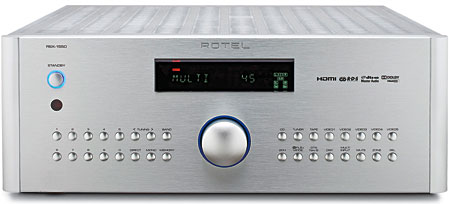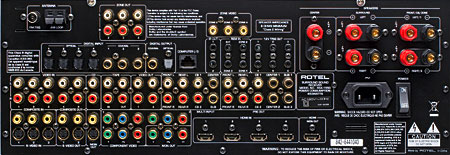Rotel RSX-1550 A/V Receiver
 Price: $1,999 At A Glance: Rotel enters the HDMI 1.3 age with two new receivers • Rated power at 75 watts times five • Snazzy aesthetics, minimalist user interface
Price: $1,999 At A Glance: Rotel enters the HDMI 1.3 age with two new receivers • Rated power at 75 watts times five • Snazzy aesthetics, minimalist user interface
Family Matters
Longtime readers will recognize the Rotel RSX-1065 as my reference A/V receiver. It’s been around so long that it’s no longer listed on Rotel’s Website. Mine has been in service since 2001, when I reviewed it, setting a record for longevity and giving every loudspeaker review I’ve written since then a firm foundation. When I tell speaker makers what I use for amplification, they breathe a sigh of relief and change the subject. Even the arrival of the seven-channel version, the RSX-1067, left me unfazed. The five-channel version has served me for nearly eight years.

But the dear old RSX-1065’s connectivity suite is growing long in the tooth. Because it doesn’t have HDMI, I no longer use it for video switching. Every time I play a Blu-ray Disc or an SACD, I have to patch six analog cables into the Rotel’s back panel. The time has come to seek a successor. Rotel offers two new possibilities, and both come with HDMI 1.3. One is the Rotel RSX-1550, which is reviewed here; the other is the RSX-1560. Both come from a distinguished family. (The following discussion will be easier to follow if you refer to information about the current family members at www.rotel.com, Products/Home Theatre/Surround Sound Receivers.)
Neither of Rotel’s two latest receivers is a direct heir of either my reference piece or its beefier brother. You can tell just by looking at them—the distinctive front-mounted heatsinks are gone. The RSX-1550 claims 75 Class AB watts times five, with all channels driven, versus 100 watts times five for my beloved RSX-1065. In that respect, it’s more of an heir of the similarly powered RSX-1057 and RSX-1058. While the new RSX-1560 does match the RSX-1067’s 100 watts times seven, it uses a Class D amplifier design that has never appeared in any previous Rotel receiver.
Why this? Why now? The crucial feature in both of these new receivers is HDMI 1.3. The RSX-1550 and RSX-1560 don’t represent Rotel’s first foray into HDMI. That came with the RSX-1057 and RSX-1058, which used HDMI 1.1 and could not process Dolby TrueHD and DTS-HD Master Audio lossless surround as native bitstreams. They also didn’t have other advantages that the latest version of HDMI brings. So the HDMI-1.3-savvy RSX-1550 and RSX-1560 are long overdue.
A truly fascinating question about them that I can’t answer right now is how the RSX-1560’s new Class D amplification compares with the RSX-1550’s more conventional Class AB. For the moment, I can only contemplate the latter.
A Sleek New Look
The RSX-1550 has a sleek, almost luminous brushed-aluminum front panel that curves at the sides. The control layout is symmetrical, with a volume knob in the middle that’s flanked by 32 buttons in four rows of eight. It also includes a large and very bright blue LED power indicator. The LED blinks off for a second when the unit goes from standby to power-on, but it is otherwise the same color and intensity all the time. The LCD learning remote has lost an inch in the vertical dimension and a half-inch in the horizontal. Its control layout is similar except for the placement of source-select buttons, which have moved from the top to the bottom.

With the addition of HDMI 1.3, the RSX-1550 can decode Dolby TrueHD and DTS-HD Master Audio lossless in bitstream form, as well as their lossy cousins, Dolby Digital Plus and DTS-HD High Resolution Audio. Rotel adds its own eXtra Surround (XS) mode, which extracts back-surround signals from non-flagged DTS-ES and Dolby EX sources. The receiver also includes a Cinema EQ mode which, when activated, reduces the brightness of certain egregiously blaring movie soundtracks. (You’ll know them when you hear them—they’re the ones that hurt.) It’s roughly analogous to THX Re-EQ, although this is not a THX- certified product.
Rotel recommends that you use the multichannel analog inputs for SACD. While HDMI can be SACD compliant from version 1.2 up, Rotel chose not to incur the licensing cost of adding SACD’s DSD codec to the receiver’s DSP. As someone who has a few hundred SACDs and uses them regularly as review ammunition, I won’t hide the fact that this came as a disappointment.
 For some users, other missing items may be as notable as what’s present. For instance, this is one of the few receivers in its price range to omit automatic setup and room correction with a supplied microphone. But it is, after all, an audiophile product. Audiophiles are unfazed by the rigors of manual setup. It takes me and my trusty SPL meter all of five minutes to set speaker distances, click through test tones, and adjust levels.
For some users, other missing items may be as notable as what’s present. For instance, this is one of the few receivers in its price range to omit automatic setup and room correction with a supplied microphone. But it is, after all, an audiophile product. Audiophiles are unfazed by the rigors of manual setup. It takes me and my trusty SPL meter all of five minutes to set speaker distances, click through test tones, and adjust levels.
Audiophiles also tend to be skeptical of room correction. The quality of room-correction schemes varies, and some cause more problems than they solve. For my own part, I’m perfectly happy with the midrange response of my room, which is loaded with absorptive and diffusive clutter. If I want to correct my room’s bass-bloating standing wave, I’d rather do it with an equalized subwoofer.
The menu includes a contour control that provides +/–6-decibel bass and treble adjustments. It’s not as convenient as the old-fashioned bass and treble knobs on my reference piece, but the contour control is more precise. It lets you adjust each channel separately. Rotel continues its laudable practice of including two sub outputs on the back panel. (They serve the same mono low-frequency-effects channel.)
I don’t want to turn into Dr. No, but the review would be less than complete if I didn’t note that there is no Sirius or XM satellite tuner, no iPod dock (optional or otherwise), no USB jack for the connection of external hard or thumb drives, and no Internet radio capability. It does have an RJ45 jack, but it is mainly for the RS-232 control interface and for firmware updates—a DB9-to-RJ45 adapter comes with the unit. While the receiver is fully compliant with the surround codecs that matter—the mainstream cinema and music modes from Dolby and DTS—it dispenses with other licensed codecs and post-processing modes. So it doesn’t have Dolby Volume, Neural Surround, etc. DSP listening modes (which, in general, are more distancing than involving) are wisely limited to four.
Video processing incorporates a marquee name in Faroudja, and the manual indicates “videophile line-doubling and scaling up to high-definition resolutions,” up to 1080p/60 hertz. See our Video Test Bench for more. On the multiroom side of things, the receiver supports up to four zones with analog video and stereo audio.
For the most part, Rotel’s minimalist choices are the ones I’d make myself if I were prioritizing parts and performance quality over neurotic feature-driven concerns. The one serious missed opportunity is the user interface. It’s still monochrome, and it requires two keystrokes to enter the main control menu—which I continue to regard as an obvious design flaw. It also seems slower and balkier than the eight-years-older version I’m used to. This is partly by design. For instance, you have to hold down a source button on the remote for a second before the receiver changes source.






























































